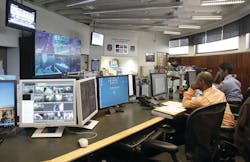Philadelphia controller disputes Mayor’s claim that police surveillance system at full capacity
The City of Philadelphia is running a little low on brotherly love when it comes to city government recently. A just-released audit from the city controller has drawn the ire of Philly Mayor Michael Nutter, who claims that reports of widespread police department video surveillance systems failures are just not correct.
Philadelphia controller Alan Butkovitz told a local television station that it was discouraging to find that less than a third of the cameras reviewed in his department’s audit were functional. The city currently has more than 216 video surveillance cameras deployed, but Controller Butkovitz said that a random sampling of 20 cameras in 2012 found that only 45 percent were actually working to spec and that the mayor’s office promised then to address the issue.
“They said by September that they’d have 90 percent working,” Butkovitz said, even though the city has spent more than $17 million on the system. “It’s now almost a year later and they’ve got 32 percent working.”
A strong critic of the system, Butkovitz has said he doesn’t think video surveillance is much of a deterrent if it works only on a 50-50 percentage basis.
Last year, Everett Gillison, Mayor Nutter’s chief of staff, said a contractor was hired to get the system in shape, and said the controller’s numbers outdated. Gillson said that at the time of the initial audit almost 70 percent of the cameras were working, and he expected that count to be more than 90 percent by September of last year.
But apparently Butkovitz is not convinced the system as been upgraded. “They said by September that they’d have 90 percent working,” Butkovitz said. “It’s now almost a year later and they’ve got 32 percent working.”
He says the problems brought to light in a study by the accounting firm Eisner Amper include blurry images with jagged, pixelated edges, making it difficult to read license plates, and condensation and water in camera domes, making it impossible to identify people.
“Suppose that had been the quality of photos in the Boston bombing or the Graduate Hospital murder,” Butkovitz told KYW radio “It’s worse than useless because it gives you a false sense of reliability.”
He says that during a recent visit to Baltimore his office found 97 percent of its 622 cameras were functioning as designed at all times.
Mayor Nutter said the controller’s report is inaccurate. “The controller is wrong. We’ve tried to explain that to him,” the mayor said. Nutter says 85 percent of the cameras are operating as they should be, “and through the course of the year it has varied from 85 percent to the low 90s.
Mayor Nutter also said there are about 1,500 cameras across the city that feed into the city’s real-time crime center.
About the Author
Staff Reports
Editorial and news reports authored by the media team from Cygnus Security Media, including SecurityInfoWatch.com, Security Technology Executive magazine and Security Dealer & Integrator (SD&I) magazine.
